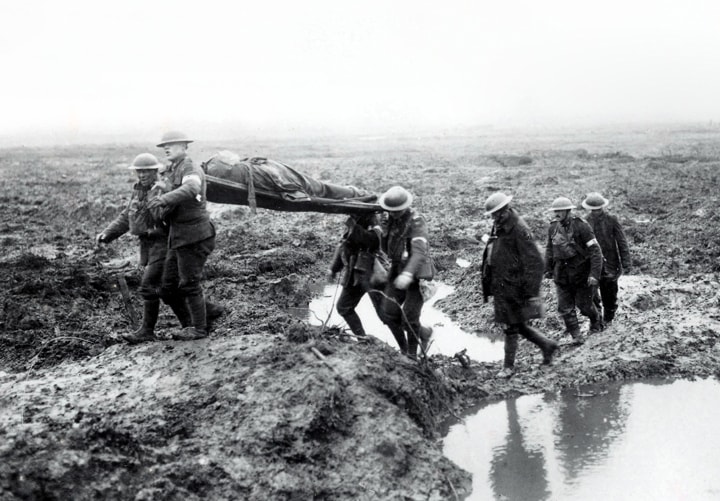
Of the many beautiful cemeteries cared for around the world by the Commonwealth War Graves Commission, the largest lies on the side of a gentle hill in Belgium. The bodies of nearly 12,000 men lie in Tyne Cot Cemetery, most of them unidentified. Another 35,000 whose bodies were never found are commemorated on a memorial wall at the top of the plot. Look back down the slope: you can see the town of Ypres below, only about five miles away. The men whose ghosts surround you now died fighting for this ground, battling up towards the village of Passchendaele which gives the battle its nickname. More properly known as the Third Battle of Ypres, it is a byword for the futility and horror of war. The famous historian A.J.P. Taylor described it as 'the blindest struggle of a blind war'. Now a hundred years on it is important to consider whether Taylor was right or whether we are ready to form a more balanced opinion.
There is no question that the cost was high, with little to show for it. Of the British, Commonwealth, French and German troops who fought, about half a million became casualties, with perhaps 150,000 men dead. The advance it took the British fourteen weeks to make, you could walk in a couple of hours today. Nevertheless, in the light of recent research, I think it was the right battle, fought in the right place for the right reasons. The problem with this battle was that the British generals fought it in the wrong way.
After the failure of the Anglo-French offensives of spring 1917, two things were clear. Firstly, doing nothing was not an option. Someone needed to attack the Germans to demonstrate commitment to allies such as America, Italy and, especially, a wavering Russia. Secondly, it was unlikely to be the French who did so. They were beset by unrest both in the army and on the home front. That left the British under Sir Douglas Haig, and the only area they could attack was in Flanders. A successful push might have secured Ypres and the supply ports at Calais and Boulogne, threatening the German rail lines behind the front. Cutting these might have forced German submarines from their bases on the Belgian coast, weakening the U-boat campaign against British shipping. And to wear down the German army could do no harm.
In the event, the British accomplished few of these objectives. The Bolshevik revolution of November 1917 took Russia out of the war. There was no breakthrough, and the German railways remained out of reach. The defenders were pushed back, but the new British positions were precarious and had to be abandoned in spring 1918. The German army had been worn down, but only at a terrible cost in experienced British troops. The battle almost broke both armies.
Why did the British fail?
The initial British assault on 31 July was too ambitious and results fell far short of expectations. Attempts throughout August to push on regardless were disjointed and achieved little more. Drier weather in September and new tactics allowed them to begin to grind through the German defences, but casualties remained heavy. In October and November downpours of rain made the battlefield a morass of mud once more. Progress slowed to a crawl. Shivering under cold rain in what little shelter the soldiers could find amid a wasteland of muddy shell craters, it was, as one German general put it, 'no longer life at all. It was just unspeakable suffering.'
The battle ended only when both sides collapsed, exhausted, into the Flanders mud. The generals let it go on too long. They were not, as Taylor thought, blind. But they had developed something like tunnel vision. For them, Passchendaele, like Stalingrad or Sangin in later wars, took on a symbolic significance far greater than its strategic value. The result was that too many brave men like the character in Siegfried Sassoon's poem, 'died in hell—They called it Passchendaele'.
The Centre for War Studies has been at the forefront of research into the First World War for over twenty years. Jonathan's next book, Haig's Enemy: Crown Prince Rupprecht of Bavaria and Germany's War on the Western Front, 1914-1918 will be published by Oxford University Press in March 2018